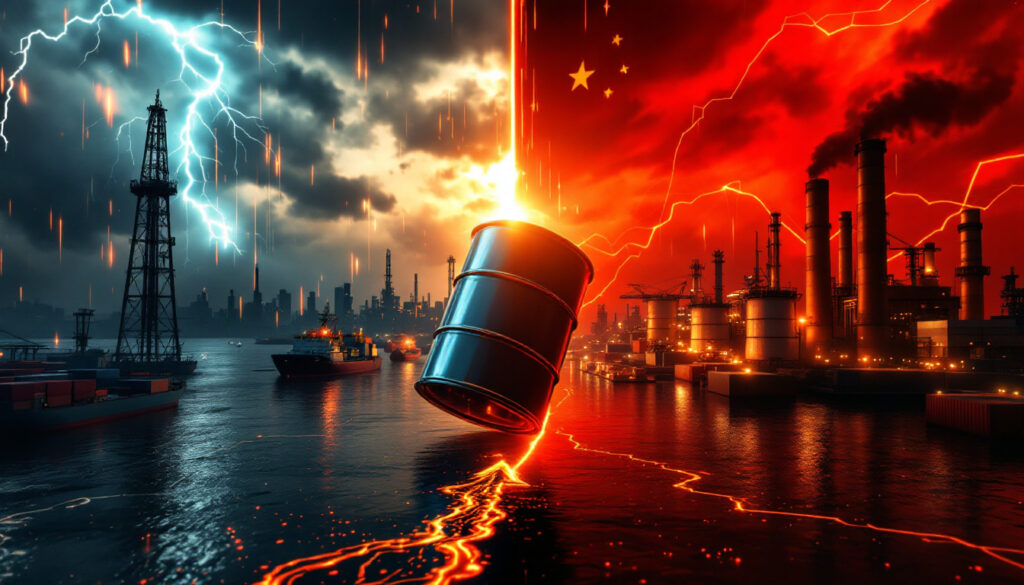How Does the US-China Trade War Impact Oil Prices?
The escalating trade tensions between the United States and China have created significant volatility in global oil markets. What began as a diplomatic disagreement has evolved into a full-scale economic confrontation with far-reaching implications for energy markets worldwide. The complex relationship between these superpowers directly influences crude oil prices through multiple economic and geopolitical mechanisms.
Global oil benchmarks have responded dramatically to each development in the trade war saga. Brent crude fell by $6 per barrel month-over-month to $64.56, while West Texas Intermediate (WTI) dropped below the psychological threshold of $60 per barrel as of April 2025. These declines directly correlate with escalating rhetoric and policy implementations between Washington and Beijing.
The energy relationship between the US and China has fundamentally transformed. Before the trade war, China represented a significant growth market for expanding US crude exports. Now, policy-driven commodity shifts have remapped global energy flows, with China seeking alternative suppliers and the US scrambling to find replacement buyers.
The Immediate Impact of Tariffs on Oil Markets
Current Oil Price Trends Amid Trade Tensions
Oil markets demonstrate exceptional sensitivity to trade tensions between the world's largest economies. When President Trump announced new tariffs on Chinese goods, WTI crude immediately plunged 4%, despite his last-minute 90-day pause on implementation. This reaction illustrates how market psychology often outweighs fundamental supply-demand dynamics during periods of geopolitical uncertainty.
Commodity traders operate with a forward-looking perspective, and the anticipation of reduced economic activity has created persistent downward pressure on oil prices and trade war impacts. US consumer prices dropped 0.3% in March 2025, a decline directly tied to falling energy costs. This deflationary pressure, while beneficial for consumers in the short term, signals concerning weakness in overall economic activity.
The market reaction to trade tensions has been notably asymmetric – negative developments trigger sharp declines, while positive diplomatic signals produce only modest recoveries. This behavior reveals the market's inherent pessimism regarding resolution prospects.
How Tariffs Trigger Price Volatility
Tariffs between major economies create immediate market uncertainty through multiple mechanisms. First, they trigger speculative selling as traders anticipate reduced economic activity. Net short positions on Brent crude rose by 22% in April 2025 as hedge funds positioned for further price declines.
Second, tariffs disrupt established supply chains, forcing companies to reconfigure logistics networks and often resulting in higher operational costs. The petroleum industry, with its globally integrated supply chains, is particularly vulnerable to such disruptions.
Third, tariffs accelerate inflationary pressures in both economies, reducing disposable income and subsequently depressing demand for transportation fuels. This ripple effect explains why oil prices often decline disproportionately compared to other commodities during trade disputes.
China's Strategic Response to US Oil Tariffs
Reduction in US Crude Imports
China has strategically reduced its intake of US crude oil since the beginning of 2025, with American oil now accounting for just 1% of China's total oil imports, down precipitously from 217,000 barrels daily in 2024. This deliberate policy shift represents both economic pragmatism and geopolitical signaling.
Chinese refiners have pivoted decisively toward alternative suppliers. Saudi Arabia's oil exports to China surged to 2.1 million barrels per day in May 2025, effectively replacing volumes previously sourced from American producers. Additionally, China has increased purchases of Russian Urals and Iraqi Basrah grades, diversifying its supply base while sending a clear message to Washington.
Chinese state-owned enterprises have also divested from US energy assets. CNOOC, for example, sold its Gulf of Mexico holdings and redirected investment toward domestic shale development. A CNOOC spokesperson noted, "Gulf of Mexico assets were sold to focus on domestic shale development and more politically stable international partnerships."
Economic Impact of High Tariffs on US Oil
With China imposing 84% tariffs on US goods, American crude has become approximately $51 per barrel more expensive for Chinese refiners, raising the effective price to $112 per barrel (based on WTI at $61). This pricing dynamic makes US crude economically unviable for the Chinese market.
Ivan Mathews, head of APAC analysis for Vortexa, noted: "This makes running US crude uneconomical for Chinese refiners." Vortexa's satellite-based tanker tracking has identified a complete cessation of US crude vessels heading toward Chinese ports, confirming the market impact of these tariffs.
The situation has particularly affected US light sweet crude producers, who had previously benefited from China's growing appetite for this grade. Companies with significant exposure to Permian Basin production have faced margin pressure as they compete for alternative export markets.
Global Economic Concerns Affecting Oil Demand
Recession Fears and Demand Forecasts
Economic forecasters have increasingly warned of recession risks as the tariff war intensifies. Renaissance Macro Research's Neil Dutta bluntly stated, "We are going into a recession," reflecting widespread market sentiment that is suppressing oil price recovery.
The International Monetary Fund has revised global GDP growth downward by 1.2% for 2025, citing trade tensions as the primary factor. Historically, each percentage point reduction in global GDP growth correlates with approximately 500,000 barrels per day less oil demand.
Industrial activity indicators show particular weakness, with BP's Q1 report highlighting "weak natural gas trading signals industrial slowdown" across manufacturing sectors. This trend directly impacts diesel demand, which serves as a key barometer of economic health.
EIA Warnings on Demand Destruction
The US Energy Information Administration (EIA) has issued explicit warnings about the negative impact of the tariff war on oil prices and trade war-related demand destruction. Their latest analysis forecasts 4% lower global oil demand growth if current tariffs persist through year-end, adding institutional credibility to market concerns about future consumption patterns.
The EIA's proprietary forecasting methodology, which incorporates high-frequency economic indicators alongside traditional oil market metrics, has proven particularly accurate during previous economic disruptions. Their dashboard now tracks real-time import/export shifts to provide greater visibility into rapidly changing trade patterns.
Supply chain disruptions have compounded demand concerns. The Keystone Pipeline shutdown reduced Canadian crude flows by 590,000 barrels per day, highlighting infrastructure vulnerabilities that exacerbate market uncertainty during periods of economic stress.
The Mechanics of Trade War Impact on Oil Prices
Inflation and Spending Patterns
Tariffs typically accelerate inflation, which reduces overall consumer and industrial spending. This economic contraction directly impacts fuel consumption across transportation, manufacturing, and energy-intensive industries.
When consumers face higher prices for imported goods, they reduce discretionary spending, including travel. US airline bookings to Asia have declined 17% year-over-year, directly reducing jet fuel consumption. Similarly, trucking volumes on major US freight corridors have contracted, cutting diesel demand.
Manufacturing sectors face particular challenges from input cost inflation. Steel tariffs have increased pipeline construction costs by approximately 25%, delaying critical infrastructure projects that would otherwise support oil market growth.
Supply Chain Disruptions
Trade disputes disrupt global supply chains, affecting the movement of goods worldwide and consequently reducing the demand for transportation fuels that support international commerce.
Container shipping volumes between US and Chinese ports have fallen 31% since tariffs escalated, directly impacting bunker fuel consumption. Manufacturers have begun regionalizing production to avoid tariffs, fundamentally altering freight patterns that have supported oil demand growth for decades.
Energy infrastructure investments have stalled amid uncertainty. Phillips 66's CEO revealed they're "halting investments until policies stabilize," a sentiment echoed across the industry. This investment freeze threatens future supply capacity just as current production plateaus.
Diplomatic Developments and Market Sentiment
Signals of Potential Negotiation
Both sides have indicated openness to negotiations, with President Trump stating, "I'm sure that we'll be able to get along very well," and noting his relationship with President Xi. Meanwhile, Beijing has expressed willingness to negotiate based on "mutual respect."
The European Union has attempted to mediate, agreeing to purchase 15% more US LNG to ease broader trade tensions. This diplomatic intervention reflects growing international concern about the global economic impact of the US-China confrontation.
Next US-China trade talks are scheduled for June 2025, providing a concrete timeline that markets can incorporate into price forecasts. The structured negotiation format represents progress compared to the ad-hoc approach that characterized earlier stages of the dispute.
Market Response to Diplomatic Signals
Despite these diplomatic overtures, oil prices have remained under pressure, suggesting that markets require concrete progress rather than mere statements of intent before adjusting their outlook.
Traders have learned from previous cycles of the trade dispute that positive rhetoric often fails to translate into substantive agreements. This skepticism contrasts sharply with the market's reaction to the 2019-2020 Phase One deal, which triggered significant price recovery before implementation details emerged.
Market psychology has fundamentally shifted toward pessimism, with traders demanding tangible results rather than promises. This sentiment shift explains why diplomatic developments that previously would have boosted prices now generate minimal market response.
Long-term Implications for Energy Markets
Structural Changes in Global Oil Trade
The trade war is accelerating changes in global oil trade patterns, with China seeking alternative suppliers and the US looking for new export markets. These structural shifts may persist even after trade tensions ease.
Saudi Aramco secured 14 new oil discoveries in Q1 2025 specifically to meet growing Chinese demand, while expanding its downstream partnerships with Sinopec to process non-US crude. These strategic investments create lasting commercial relationships that will be difficult for US producers to displace, even if tariffs eventually disappear.
US Gulf Coast export infrastructure, developed largely to serve anticipated Chinese demand growth, now faces utilization challenges. Mubadala Energy has opportunistically entered the US gas market via a $1.4 billion acquisition, capitalizing on depressed asset values resulting from reduced Chinese purchases.
Investment Impacts on Energy Infrastructure
Uncertainty around future trade policies is affecting investment decisions in energy infrastructure, with American refiners reportedly refraining from making new investments amid the current climate of uncertainty.
Updated estimates show the US Gulf holds 48 billion barrels of untapped oil, but development timelines have extended as companies adopt more conservative capital allocation strategies. The American Shale CEO advised producers to "stop drilling right away to balance markets" until demand clarity emerges.
US wind energy growth forecasts have been cut by 40% due to Trump's energy policies and economic uncertainty, highlighting how trade tensions affect even tangentially related energy sectors. This investment paralysis threatens to create supply constraints when demand eventually recovers.
How to Navigate Oil Markets During Trade Disputes
Indicators to Monitor
Investors and industry participants should closely track diplomatic developments, tariff implementation timelines, and changes in import/export patterns between the US and China to anticipate oil price movements.
Monitoring OPEC+ compliance rates provides crucial context for understanding how other producers respond to US-China trade dynamics. Production discipline has historically weakened during periods of demand uncertainty, amplifying price declines.
Hedging activity offers valuable signals about market sentiment. US shale firms increased futures contracts by 33% in Q1 2025, revealing their concerns about continued price vulnerability. This defensive positioning creates additional selling pressure in futures markets.
Hedging Strategies for Price Volatility
Companies exposed to oil price fluctuations may need to implement more robust geopolitical investor strategies to manage the increased volatility resulting from unpredictable trade policies.
Diversification into renewables represents another risk mitigation approach, with the EU's eased storage targets providing supportive policy frameworks. Many integrated energy companies have accelerated their transition strategies in response to fossil fuel market uncertainty.
Options strategies that provide downside protection while maintaining upside exposure have gained popularity. The asymmetric risk profile of the current market – where negative developments produce outsized price movements – makes traditional linear hedges less effective than structured protection.
FAQ: Trade War and Oil Prices
How much have US oil exports to China declined?
US oil exports to China have shrunk considerably since early 2025, now representing just 1% of China's total oil imports, down from approximately 217,000 barrels daily in 2024. This dramatic shift reflects both policy decisions and economic realities created by tariff barriers.
What happens to oil prices if a US-China trade deal is reached?
If a comprehensive trade deal is achieved, fears of global recession should dissipate, potentially leading to a significant recovery in oil prices as demand outlook improves. Historical precedent suggests price recoveries of 15-20% are possible following successful resolution of major trade disputes.
How do tariffs specifically affect oil demand?
Tariffs increase prices of goods, reduce consumer purchasing power, slow manufacturing activity, and disrupt supply chains—all factors that collectively reduce fuel consumption and energy demand. Transportation fuels are particularly vulnerable to these effects, as they directly reflect economic activity levels.
Are all oil-producing countries equally affected by the trade war?
No. Countries heavily dependent on exports to China or the US face greater impacts, while producers with diversified customer bases may be more insulated from bilateral trade disputes. Saudi Arabia has benefited from China's pivot away from US crude, while Canadian producers face particular challenges due to their high reliance on US refining capacity.
The Outlook for Oil Prices as Trade Tensions Evolve
The future trajectory of oil prices remains closely tied to developments in US-China trade relations. While current market sentiment remains pessimistic, any substantive progress toward resolving the tariff dispute could quickly reverse the negative outlook for oil demand.
The structural changes in global oil trade patterns will likely outlast the current tensions. China's strategic diversification away from US energy supplies reflects a broader geopolitical recalibration that transcends specific tariff disputes. Similarly, US producers' efforts to develop alternative export markets will continue regardless of diplomatic developments.
Industry resilience remains a crucial but underappreciated factor. As one market analyst noted, "If it takes nothing less than a global recession to stem growth in oil demand, then it's safe to say that demand is quite solid." This underlying strength suggests that when trade tensions eventually ease, global commodity insights indicate oil markets could experience a robust commodity super-cycle that catches pessimistic traders by surprise.
Want to Spot the Next Major Mineral Discovery?
Discover how significant mineral finds can lead to exceptional market returns by exploring Discovery Alert's dedicated discoveries page. Powered by the proprietary Discovery IQ model, Discovery Alert delivers real-time notifications on ASX mineral discoveries, giving you the market edge to capitalise on opportunities before they become mainstream.




